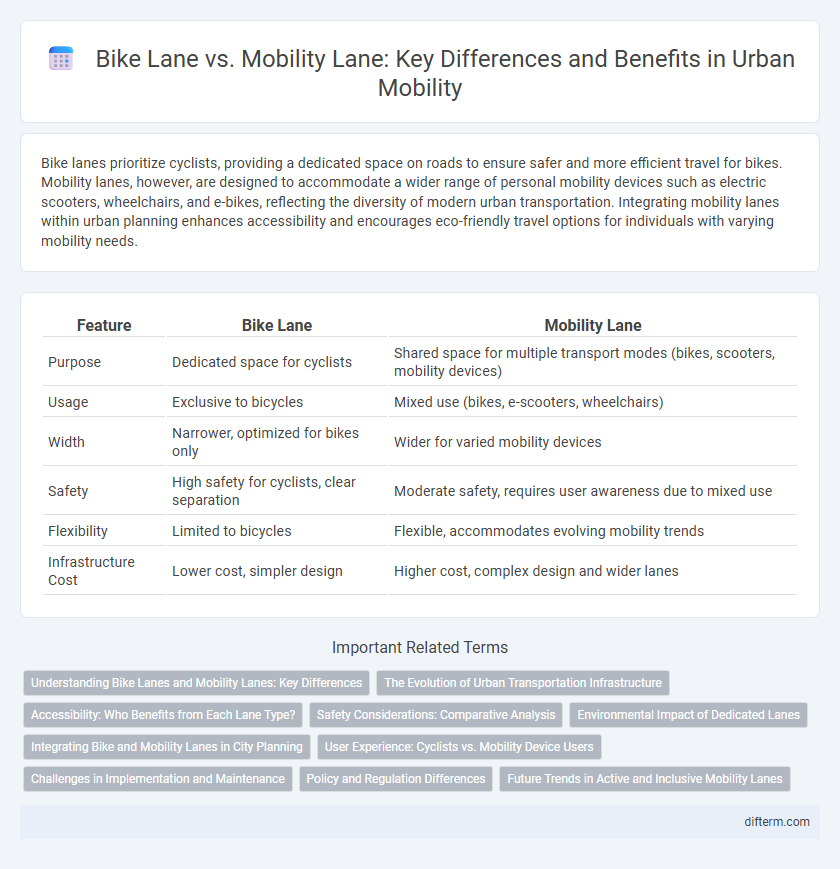Bike lanes prioritize cyclists, providing a dedicated space on roads to ensure safer and more efficient travel for bikes. Mobility lanes, however, are designed to accommodate a wider range of personal mobility devices such as electric scooters, wheelchairs, and e-bikes, reflecting the diversity of modern urban transportation. Integrating mobility lanes within urban planning enhances accessibility and encourages eco-friendly travel options for individuals with varying mobility needs.
Table of Comparison
| Feature | Bike Lane | Mobility Lane |
|---|---|---|
| Purpose | Dedicated space for cyclists | Shared space for multiple transport modes (bikes, scooters, mobility devices) |
| Usage | Exclusive to bicycles | Mixed use (bikes, e-scooters, wheelchairs) |
| Width | Narrower, optimized for bikes only | Wider for varied mobility devices |
| Safety | High safety for cyclists, clear separation | Moderate safety, requires user awareness due to mixed use |
| Flexibility | Limited to bicycles | Flexible, accommodates evolving mobility trends |
| Infrastructure Cost | Lower cost, simpler design | Higher cost, complex design and wider lanes |
Understanding Bike Lanes and Mobility Lanes: Key Differences
Bike lanes are designated paths on roads specifically for cyclists, enhancing safety by separating bike traffic from motor vehicles. Mobility lanes are broader transportation corridors designed to accommodate various modes, including bikes, buses, and shared vehicles, optimizing traffic flow and accessibility. Understanding these differences is essential for urban planning strategies aimed at reducing congestion and promoting sustainable transportation.
The Evolution of Urban Transportation Infrastructure
Bike lanes have transformed urban transportation by offering safe, dedicated spaces for cyclists, reducing traffic congestion and promoting sustainable mobility. Mobility lanes, designed for multi-modal use including e-scooters and shared bikes, represent the next step in flexible urban infrastructure adapting to diverse commuter demands. The evolution from singular-purpose bike lanes to integrated mobility lanes demonstrates a shift towards inclusive, efficient, and environmentally friendly city transit networks.
Accessibility: Who Benefits from Each Lane Type?
Bike lanes primarily benefit cyclists by providing safe, dedicated space that reduces conflicts with motor vehicles, enhancing accessibility for both recreational and commuter riders. Mobility lanes accommodate a broader range of vehicles, such as buses, emergency vehicles, and sometimes carpools, improving transit efficiency and accessibility for public transport users and multi-occupant vehicles. Urban areas prioritizing inclusivity and reduced congestion often integrate both lane types to maximize accessibility for diverse transportation modes and user groups.
Safety Considerations: Comparative Analysis
Bike lanes significantly enhance cyclist safety by providing dedicated space that reduces interactions with motor vehicles, thereby lowering accident rates. Mobility lanes, which accommodate various forms of transport including buses and bikes, offer flexibility but may increase risk due to mixed traffic and potential conflicts. Studies indicate that separated bike lanes reduce injury risk by up to 50%, emphasizing the safety advantage over shared mobility lanes.
Environmental Impact of Dedicated Lanes
Dedicated bike lanes significantly reduce vehicle emissions by encouraging cycling over car use, which lowers carbon footprints and air pollution in urban areas. Mobility lanes designed for shared use may still reduce congestion but often sustain higher emissions due to mixed traffic with motorized vehicles. Prioritizing exclusive bike lanes enhances environmental benefits by promoting zero-emission transportation and improving urban air quality.
Integrating Bike and Mobility Lanes in City Planning
Integrating bike lanes and mobility lanes in city planning enhances urban transportation by providing safe, dedicated spaces for cyclists and shared mobility devices, reducing traffic congestion and emissions. Effective design prioritizes connectivity, ensuring mobility lanes accommodate diverse users while maintaining efficient traffic flow. Incorporating smart infrastructure like sensor-based signals and clear signage boosts safety and encourages sustainable transport choices.
User Experience: Cyclists vs. Mobility Device Users
Bike lanes primarily cater to cyclists, offering a dedicated, smooth, and often physically separated path that enhances safety and riding comfort. Mobility lanes, designed for a broader range of users including electric wheelchairs and mobility scooters, feature wider dimensions and smoother surfaces to accommodate various device sizes and speeds. User experience improves significantly when lane design considers the specific needs of each group, reducing conflicts and ensuring safe, comfortable travel for all mobility users.
Challenges in Implementation and Maintenance
Bike lanes often face challenges such as limited space availability, high installation costs, and conflicts with existing road infrastructure, making their implementation complex in urban settings. Mobility lanes, designed for multiple transport modes, require sophisticated traffic management systems and continuous maintenance to ensure safety and efficiency amid mixed-use traffic. Both types demand ongoing investment in signage, surface upkeep, and enforcement to address wear, vandalism, and user compliance issues effectively.
Policy and Regulation Differences
Bike lanes are regulated specifically to prioritize cyclist safety and often include strict design standards and speed limits under urban mobility policies. Mobility lanes, designed for multiple modes of transport including buses and scooters, are governed by broader traffic regulations that emphasize multimodal flow and congestion reduction. Policies regulating mobility lanes typically incorporate adaptive use permits and dynamic lane assignments to maximize urban transport efficiency.
Future Trends in Active and Inclusive Mobility Lanes
Future trends in active and inclusive mobility lanes emphasize the integration of bike lanes with multimodal mobility corridors designed to support diverse user needs, including pedestrians, cyclists, and micro-mobility devices. Urban planners are increasingly adopting smart infrastructure equipped with sensors and adaptive signaling to enhance safety and traffic flow in these lanes while promoting sustainability and equity. The shift towards inclusive mobility lanes reflects a broader commitment to reducing carbon emissions and fostering accessible, health-oriented urban environments.
bike lane vs mobility lane Infographic

 difterm.com
difterm.com